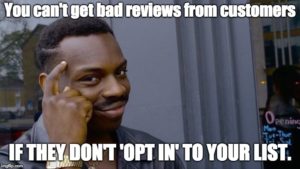Online review/reputation management companies like Birdeye, GetFiveStars, ReputationLoop, ShoutAboutIt, Grade.us and others have systematized the collection of online reviews. Most of these companies provide some type of automated email solicitation to your customers with a simple, two-step quiz:
Step 1: “Thanks for your order. How did we do?”.
If your customer answers they had a good experience, he or she receives
Step 2: a second email explaining how to share that good experience on Google, Yelp, Facebook or dozens of other sites.
If your customer is less than satisfied, they’re ignored or get escorted (by private email or phone call) into a DMZ to deescalate tensions and work out differences. The process is called ‘review gating’ and, on April 12, Google updated its terms of service for reviews warning companies to specifically stop the practice. The key phrase: “Don’t discourage or prohibit negative reviews or selectively solicit positive reviews from customers.” While some experts feel this is more of an optional guideline, review/reputation management companies like BirdEye and GetFiveStars have announced fundamental changes in their software flow to comply.
Last year, Yelp amped up its TOS to specifically say that businesses should not even solicit reviews. Seriously.
Implications for Small Business
These sorts of rules and guidelines help websites maintain the integrity of their reviews platforms. But they can be devastating to small business owners. As any business owner knows, it’s not a great idea to give an angry customer the idea (and the tools) to leave an angry online review. And, considering that many small businesses have precious few online reviews, a few bad reviews can be devastating. Fake reviews (sock puppet reviews, revenge reviews, competitor reviews) can drown a business. Curbing marketing programs to generate more reviews – and positive reviews – puts up big roadblocks. So, how can a small business thread the needle of getting more online reviews, and more favorable online reviews?
Here are five quick tips:
1. Embrace the danger.
48 hours after Google made the change, FiveStarSystems (another review management platform), conducted an experiment about the implications of removing a gating option. Surprisingly, according to their preliminary data, only 2% of ungated reviews collected were one-star while a whopping 96% were 4- and 5-star reviews. The lesson: most disgruntled people will just ignore the opportunity to double down and publicly label themselves as a scold or malcontent.
So, asking all customers for a review (and specifically avoiding asking for a favorable review), can be viable. Consider, too, that an unnaturally high number of good reviews looks suspicious. You’ll probably undercut your own review efforts when everyone looks like a shill. Even when you get the occasional nasty review, do what Michael Voltaggio (celebrity chef at LA’s Ink Restaurant) does and shoot a video reading mean Yelp reviews (a la Jimmy Kimmel segment where celebrities read mean tweets). It is a brilliant/cocky way to deflect the negative attention, shame unfair reviewers, intimidate would-be critics, and perhaps humanize your business to undecided customers.
2. Survey customers if they were satisfied. Period.
Review gating violations occur when you deliberately solicit reviews only from happy customers. It seems well intentioned, but it can backfire. This two-step cherry-picking seems a bit insincere to the happy customers who just took your survey. Customer feedback (Step 1) probably should be separate from reviews (Step 2) anyway. You can generate significant insights into your business by gathering honest feedback. The problem occurs when you try to link private feedback with public online reviews.
3. Do Not Automatically Send Review Requests to All ‘Customers’
I personally believe the intention of Google’s TOS change on review gating is to prevent businesses from soliciting (or discouraging) online reviews based on customer sentiment. However, the obverse is not true: you are not required to solicit reviews automatically from all transactions. Accordingly, sending requests linked to ALL sales is probably a big mistake. Such a procedure runs the risk of triggering bad reviews by aimlessly soliciting everyone who purchased your product or service.
Review marketing is about building relationships with people who like and trust your brand. This is yet another good reason to use double opt-in on your company mailing list. Potentially unhappy or indifferent customers are unlikely to agree to receive your content. The remaining audience is likely to be much smaller but much more agreeable.
4. Solicit Reviews in the Correct Context
Most online review publishers allow you to market your reviews. And most people do filtered the reviews they publish, so customers see the best reviews. In that environment (surrounded by the halo of good reviews), place a prominent link encouraging people to “leave a review”, linking to your review service or directly to the review page of your choice. You should also include link anchor text to your curated reviews on your website using phrases like “Read our 5-star reviews”. Consider putting a link on that page inviting visitors to leave a review.
5. Wait a few weeks, even months
In a 2016 article in the Journal of Consumer Psychology, researchers Huang, Burtch, Hong, & Polman found that reviews tended to be more positive as time passed. There was also a multiplier effect between time & distance, the further away the reviewer lived from the restaurant, combined with the ‘temporal’ distance, tended to make the reviewer’s comments a bit more favorable. This study implies that it may be a good idea to program some automatic delay before you request a review from customers. As the sayings go: time heals all wounds and distance makes the heart grow fonder.
Conclusion
Ending the practice of cherry-picking reviews is probably going to be adopted by all review-gathering services. It is also probably best for your marketing efforts. While it is true that many businesses may run the risk of more negative reviews, the overall review picture will be a more authentic snapshot of your business. To be successful, you should have a review-marketing policy that actively tries to increase overall review activity: monitor the most credible review sites for ALL reviews about your business, good or bad, then establish procedures for responding to customer feedback quickly.
As per the new Google policy, invitations to give reviews should not be gated. But you should be smart about automated or indiscriminate requests. If you have great, authentic reviews, make sure you are properly exploiting them. To comply with the spirit of Yelp’s policy, consider making inferential review requests. A page on your website entitled “Read Our Online Reviews” establishes a confident halo effect that can entice customers to give you similarly glowing reviews. And, if you have negative reviews, don’t ignore them. Engage – publicly or privately – to demonstrate that you care about your business and its reputation. You may not succeed in appeasing the negative reviewer, but you will go a long way to demonstrate your customer service attitude to the hundreds or lurkers in the audience that are watching the drama play out.






